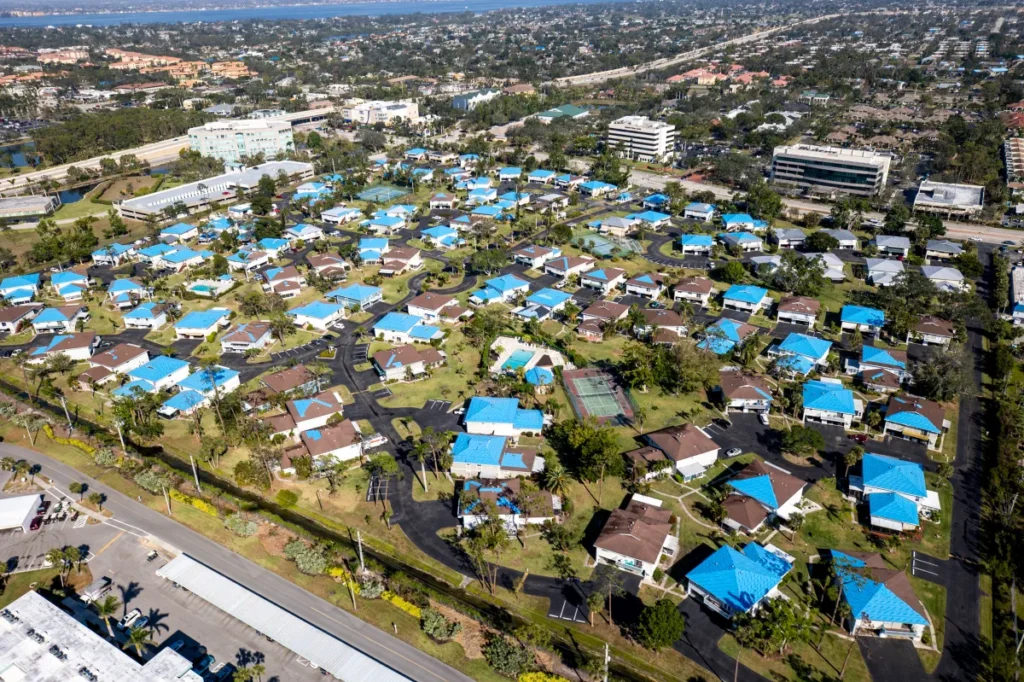First, some good news for insurance consumers in South Florida: The average annual cost to insure a single-family home increased at a lower percentage rate in Broward and Miami-Dade counties than in Florida’s other 65 counties, according to data released by the state.
Homeowners along Florida’s Gulf Coast and its northern border experienced premium increases at much-higher percentages, likely because more hurricanes have been striking those regions, but also because populations there have been growing and creating higher risks of property destruction from those hurricanes, experts say.
Now the bad news: Average premiums in Broward, Palm Beach, Miami-Dade and Monroe counties are still the highest in the state. That’s based on a comparison of data released twice yearly since 2022 in the Office of Insurance Regulation’s Property Insurance Stability Report.
The price increases occurred despite legislative reforms in 2022 to reduce access to legal fees that insurers said fueled an unprecedented rise in costly litigation. Proponents predicted rates would fall in two years, and many have, but insurers say inflation of reconstruction costs and other factors have so far caused homeowners’ costs to continue to rise.
Broward’s average annual premium increased by 31%, or $1,489 — to $6,291 between March 2022 and September 2024 while Miami-Dade’s increased by a comparatively cheaper 21.1%, or $1,077 — to $6,170 during the same period.
One possible reason for the lower rate of increase is that a high percentage of homeowners in the two counties rely on state-owned Citizens Property Insurance Corp. The state has capped how high it can raise its rates each year.
The average premium of another county with a high percentage of Citizens customers, Monroe, increased at the fifth-lowest percentage rate, 34.6%, which added $2,329 to the state’s most expensive average premium — a whopping $9,058.
The 65 counties that saw larger percentage rate increases includes Palm Beach, where average premiums increased by 37.5% and is now $6,614. That’s a price increase of $1,803 over two and a half years.
Insurance costs, of course, vary from house to house, county to county, region to region and state to state depending on a wide variety of factors.
Chief among them is the cost of hurricane coverage, and the four South Florida counties have long been considered the most likely region to be struck by hurricanes. Other factors that have driven rates higher in South Florida include higher property values and a greater volume of lawsuits stemming from disputes over insurance claims involving those higher-value properties.
But the higher frequency of hurricanes striking the west coast of Florida in recent years appears to be driving premiums higher in counties that stand in their way.
Insurance costs catching up along Gulf Coast, northern counties
In Southwestern Florida, where Hurricane Ian struck in September 2022, average premiums in Charlotte, Lee, Sarasota, Hardee, Desoto and Manatee counties increased between 45% and 50%. In Lee County, homeowners who had been paying an average of $2,515 before Hurricane Ian pummeled Fort Myers Beach, saw their average premium rise 47% to $3,696.
The same thing happened in the cluster of seven north Florida counties west of Jacksonville that were in the path of Hurricane Irma in 2017, Hurricane Elsa in 2021, and Tropical Storm Colin in 2022. Average premiums in Hamilton, Suwannee, Lafayette, Columbia, Baker, Union and Bradford increased at percentages ranging from 37.1% to 47.4%, just in time for Hurricane Idalia to strike the region in September 2023. Between March 2022 and September 2024, average premium increases have ranged from 46.4% to 52.8%.
Along the west coast, average premiums for all contiguous counties from Taylor, just east of the Big Bend, to Collier, just north of Monroe, increased by 40% or more, and by less than 40% in all east coast counties between St. Johns and Monroe, except for Indian River (43.9%).
Since Hurricane Irma entered Florida on the southwest coast in 2017, 15 hurricanes or tropical storms have hit Florida’s west coast, according to an online log of hurricane tracks by the National Oceanic and Atmospheric Administration. Only four have brushed or struck the east coast, the website shows.
Not since Wilma has a major hurricane crossed South Florida, and it struck the west coast first.
Six hurricanes that have struck the state over the past three years have impacted the Gulf Coast from Marco Island to the Big Bend, said Mark Friedlander, communications director for the industry funded Insurance Information Institute. “It is no surprise that we would see the largest cumulative average home insurance premium increases in these counties compared to South Florida counties of Broward and Miami-Dade,” he said.
Guy Fraker, a consultant who has authored studies about insurance litigation and its effect on rates, told the South Florida Sun Sentinel that increases in the intensity of convective storms and more hurricanes in a warming gulf are driving rates in western and central counties to catch up to those in southeastern counties.
“This means Central Florida counties now face vulnerabilities that historically have not been present,” he said.
Don Matz, CEO of Orange Insurance Exchange, said insurance rates are driven by claims experience over recent years “with the most weight being applied to the most recent year’s data.”
A major factor, he said, is the cost of reinsurance, which accounts for an estimated 30% to 50% of premiums. “Reinsurance pricing is driven off of expected loss to a given area as determined by hurricane models, which have changed their view of risk over the last couple of years,” he said.
Brian Murphy, owner of The Murphy Agency, a Brightway affiliate, in Palm Beach Gardens, said it makes sense that rates will increase in areas that become more vulnerable to hurricanes.
“We all know and need reminding sometimes that Florida’s insurance market is heavily influenced by storm damages and past claims,” he said. Areas with repeated hurricane impacts and high claims payouts will naturally see steeper rate increases as insurers adjust for risk.”
Friedlander sees another factor driving up rates on the west coast: a growing population. He says it’s happening in coastal counties across all hurricane-prone states.
“More people are living in harm’s way of catastrophes than ever before,” Friedlander said. “More density means a higher probability of widespread property destruction from a landfalling hurricanes. This factors into insurers’ risk modeling.”
Why do South Florida premiums remain high?
A statewide average premium for March 2022 was not available in data released in the state’s Property Insurance Stability Report in July 2022. However, since the second quarter of 2022, the state has released statewide data going back to the second quarter for each regulated insurer and coverage type. That data shows that the average statewide premium has increased for residential homeowners by 31.1% since June 2022.
According to these figures, the statewide average premium for single-family homeowners in September 2024 was $3,668 —much more than what South Florida homeowners are paying but still above averages paid in 52 counties, including Orange, Hillsborough, Sarasota, Brevard, and St. Lucie.
After the Sun Sentinel reported that statewide average figure in January, Barbra Nightingale, a Sun Sentinel reader, emailed to say that the number seemed “way off.” She added, “I’m sure there are many seniors like me who are facing similar issues.”
Nightingale said that she’s paying more than $9,000 a month to insure her 2,600-square-foot house in Hollywood Hills, up from $3,500 five years ago.
Despite the absence of major hurricanes over the past two decades, insurance costs remain high in South Florida because property values are higher in the region and inflation has driven up the cost to repair or replace damaged homes, says Dulce Suarez-Resnick, vice president at Miami-based insurance agency Acentria.
That’s because building codes in Broward and Miami-Dade counties are stronger. “In the other counties, there are a lot of older homes built with frame construction or mixed frame and concrete block with roof structures not as sturdy as ours,” she said.
It creates a double-edged sword for South Florida homeowners who invest in maximum home-hardening improvements, then find their premiums increased anyway because the improvements increased their home’s insurable value.
Lawsuits also persist in the tricounty region at a higher rate than in other regions of the state. That drives up claims costs and premiums.
Premiums in South Florida would likely have increased more if the Legislature hadn’t enacted reforms in 2022 and 2023 to restrict legal costs from growing out of control, Murphy said.
While South Florida homeowners might think they deserve a break because the hurricane risk has shifted, Locke Burt, chairman and CEO of Security First Insurance, said that hurricane-risk modelers look at the potential for storms to strike anywhere in the state. And models conclude that the entire state faces increased risks for hurricanes, he said.
Prior to Wilma, all of the storms cited by hurricane modelers to project the future costs of storms were ones that struck South Florida, he said, including the 1926 Greater Miami hurricane, the deadly Okeechobee storm two years later, a 1947 storm that hit Fort Lauderdale, Donna in 1960, and Andrew in 1992.
Since then, Burt said, “Miami has escaped, and Fort Lauderdale has escaped hurricanes for years and years and years and years. That’s looks like a historical anomaly.” Hurricane-risk models take hundreds of years into account and involve tens of thousands of simulations, he said. “One or two years of storms is not going to necessarily change the modelers’ view of hurricane risk.”
Ron Hurtibise covers business and consumer issues for the South Florida Sun Sentinel. He can be reached by phone at 954-356-4071 or by email at [email protected].





















